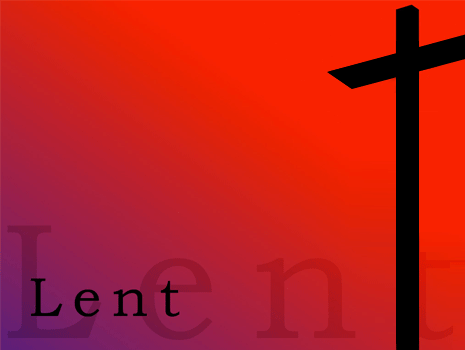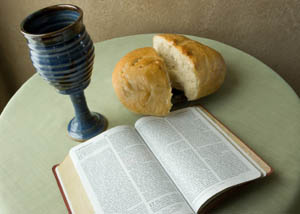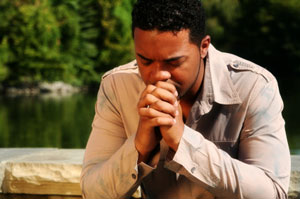Cultural Resources

(Season of Lent: February 25–April 11, 2009)
CULTURAL RESOURCES
Sunday, March 1, 2009
Jonathan Langston Chism, Guest Cultural Resource Commentator
Doctoral Student in African American Religion, Rice University, Houston, TX
I. Historical Background and Documents
In the second century, Lent was the period in which new Roman Catholic converts (catechumens) went through an intense process in preparation for baptism at the Easter Vigil. Over the next few centuries, the tedious process of the catechumen began to diminish; as a result, during the fourth century, Lent became a forty day period of penitence and fasting for all Christians, not only new converts.1 In A.D. 325, the Council of Nicaea referred to Lent as a forty day period that precedes Easter on the Christian calendar. The number forty is significant in light of Jesus’ forty day period of fasting in the wilderness in preparation for his ministry (Matthew 4:1-2).2
Today, Lent consists of the forty days before Easter in which Christians prepare to celebrate the resurrection of Jesus Christ by practicing the spiritual disciplines of fasting, prayer, and penitence. Sundays are always excluded as fast days during Lent because they are mini-Easters that symbolize the weekly celebration of Jesus’ resurrection. Many Western churches only exclude Sundays as fast days during Lent, but Eastern Orthodox Churches exclude both Saturdays and Sundays. Subsequently, in Eastern Orthodox churches, the season begins earlier and is spread out over a longer period of time. Despite differences in chronological arrangement, both Western and Eastern churches honor the period for a minimum of forty days.3
Many African American Christians who follow the liturgical calendar, such as Roman Catholics, Episcopalians, and United Methodists, value the season of Lent as a time for embracing physical weakness through deliberate self-denial in order to secure spiritual strength in Christ (2 Cor. 12:7b-10). Furthermore, many African Americans who have not followed the liturgical calendar can find value in Lent’s symbolic power as a season of preparation for celebration.
II. Cultural Responses
Two-a-days: A Metaphor for Lent
Though my native Church of God in Christ denomination does not honor Lent, I value what Lent signifies. I experienced seasons similar to Lent during my career as a varsity football athlete. I had summer two-a-day football practices. During two-a-day practices, head coaches require that varsity football athletes practice twice a day. The players have one long practice session in the morning, and they complete another lengthy practice session in the evening. The purpose of two-a-days is to prepare varsity athletes for the season that lies immediately ahead. During practice sessions, coaches push athletes to get physically and mentally in shape by running sprints, lifting weights, performing specific drills, practicing plays, watching game film, studying playbooks, etc. The intense two-a-day practices that I endured for four consecutive summers at Rice University are a metaphor for Lent as a season of preparation. During Lent, Christians prepare to celebrate their faith in the resurrection. During summer two-a-day practice sessions, varsity football players prepare in anticipation and hope of celebrating a victorious football season.
Like many athletes, I found the practice sessions to be brutally challenging each summer. My eyes were often irritated from sweat, as the extreme August heat and humidity were double forces in Houston, Texas. My muscles were sore and my body ached from constant pounding and aggressive hitting by fellow three hundred pound players. Despite all of these discomforts, I knew that the pain of two-a-days was a necessary component of preparing for the challenges of the football season. In order for me to be strong on game day, to evade and shed blockers so that I could forcefully tackle opposing running backs and sack opposing quarterbacks, I needed to push myself to endure the pain of two-a-days. Even when I did not have the will to push myself, my coaches and teammates held me accountable during this tough process. The championship game is not won on game day, but teams win championships during spring football practice, summer work outs, and certainly during the period in which players engage in two-a-days.
Analogous to my two-a-day summer practice sessions, the season of Lent is a period in which Christians become uncomfortable through self-denial. The reward of participating in Lent is not the hope of winning a championship or being selected for a Bowl game, the reward is becoming one with the resurrected Christ and allowing His power to be perfected in one’s weakness (2 Cor. 12:10; Philippians 3:13-14).
III. Valuing the Spirit of Lent in African American History
Standing on the platform of the historic Mason Temple Church of God in Christ, Dr. Martin Luther King, Jr. prophetically concluded his renowned “I’ve Been to the Mountain Top” speech, saying:
And he’s allowed me to go up to the mountain. And I’ve looked over. And I’ve seen
the Promised Land. I may not get there with you. But I want you to know tonight,
that we, as a people, will get to the promised land!4
Dr. King believed that the resurrection of Christ had implications for African American people and all oppressed persons. His life is a testament of Lent, as he willingly denied himself some personal comforts in faith and hope of African Americans reaching the promised land in America. His assurance that African Americans “will get to the promised land,” was not empty, but was filled with the commitment and sacrifice of many African American men and women during the Civil Rights era.
Far beyond King, and throughout history, numerous African Americans in various social spheres, e.g., the political, religious, educational, military, entertainment, and athletic have undergone intensive seasons of preparation and spiritual discipline in order to advance themselves and forge progress in American society. Harriet Tubman, Sojourner Truth, Nat Turner, and Frederick Douglass sacrificed much of their lives to abolish slavery. Despite the intense racial prejudice of the period, Hiram R. Revels was the first African American elected to the United States Senate in 1870. James Weldon Johnson, Langston Hughes, Jessie Fauset, and Zora Neale Hurston made valuable contributions to the Harlem Renaissance, a significant blossoming period of black art and literature in American history.5
Since March is also Women’s History Month, in athletic competition, one may consider the achievements of the 1988 Associated Press Female Athlete of the Year, Florence Griffith Joyner, also known as Flo Jo. At the 1988 Seoul Olympics, Joyner won a gold medal in the 100-meter dash, shattering the Olympic record with her unbelievable time of 10.54 seconds. Joyner did not achieve her personal goals and dreams without preparation and sacrifice; she was willing to endure pain and overcome obstacles.6 While one can find numerous examples, the point of emphasis is that many prominent African Americans undoubtedly endured a Lenten season in their lives prior to gaining standing in their respective fields and paving the way and creating opportunities for other African Americans and other marginalized groups.
One should be careful to distinguish the hardship of Lent, which is voluntary and willing self-sacrifice, from the unwelcome and forced adversity many African Americans have experienced throughout their history in America. During Lent, persons freely and purposely choose to grow in their relationship with God by presenting themselves as living sacrifices, ascetically fasting from food, drink, or a specific commodity for a season (Romans 12:2).
The stories of African Americans who have willingly endured pain and have committed to toil to aspire for achievement and greatness can inspire one to appreciate and value the Lenten seasons of life as necessary periods of preparation. The African American historical narrative proves that a sincere commitment to struggle, discipline, and self-sacrifice are prerequisites to progress and excellence. Not only can Lent help African American Christians appreciate and live the power of Christ’s resurrection but, on a broader level, the spirit of Lent can inspire African Americans in their strides towards excellence and liberation.
IV. Lenten Suggestions for African American Churches
The National Council of Churches offers the following three recommendations for celebrating Lent from an African American perspective. Involving youth in these types of activities is important for passing down the tradition of Lent.
- Focus on Christian spiritual disciplines in Christian education classes and Bible studies. I recommend that Christian education directors and teachers develop classes and bible studies in relationship to one of the following books: Richard Foster’s Celebration of Discipline: The Path to Spiritual Growth; Howard Thurman’s With Head and Heart: The Autobiography of Howard Thurman; or Renita Weem’s Listening to God: A Minister’s Journey through Silence and Doubt.
- Incorporate Africana elements such as drums and dance into the Call to Worship during the season of Lent.
- Encourage families to share a Sunday meal together during Lent and to reflect on how God has given them strength and power in the midst of their personal and social struggles.7
Other possible Lenten activities: - Participate in community service initiatives, such as volunteering at a school or facility for developmentally disabled persons, volunteering at a homeless shelter, or a nursing home. Don’t just visit, volunteer.
- Develop meditative prayers for your congregation for Lent or a Lenten Devotional Booklet that addresses the spiritual needs of your congregation during a given year. In 2006, Saint James United Methodist Church in Kansas City, Missouri, assembled a devotional calendar called “40 Meditations of Hope, Strength, and Unity.” The calendar provided members with a specific text and a brief inspirational reflection each day of the forty day period.8
- Develop a Forty Day Embrace and Relinquish List – Have persons covenant to participate in embracing and relinquishing activities:
| Embrace for Forty Consecutive Days | Relinquish for Forty Consecutive Days |
| Healthy eating | Salt, sugar and fried foods |
| A mammogram | Not getting check-ups |
| Volunteering at a school | Watching the world go by |
| Exercising | Not exercising |
| Living by a budget | Not living by a budget |
| Being politically active | Only voting as a political activity |
| Reading the Bible weekly | Only reading the Bible at church |
| Quitting smoking | Smoking |
| A colonoscopy | Excuses for not going to the doctor |
| Forgiveness | Holding grudges, hate and resentment. |
V. Visual Suggestions for Use in Churches, Including On Screens
- Your Church Altar – Place a stand-up poster on your church altar that contains the words, “Do This In Remembrance of Me” and an image of bread and wine or a similar image. This will remind worshippers that we are to present ourselves to God as living sacrifices (Romans 12:2). If you have a screen in your church, put the image on-screen with the same wording. Be sure to give an explanation for this in your church bulletin/order of worship. In fact, all Lenten activities should be advertised two weeks prior to the beginning of your Lenten activities.

"This Do In Remembrance of Me."
- A long distance runner – Use a picture of a long distance runner to encourage persons to endure when they are tired and weak (Hebrews 12:1-2). The image below or a similar image can be placed in your church bulletin/order of worship, on church bulletin boards, on classroom doors, screens, etc., throughout the Lenten season.

“Run and Finish the Race.”
- An Image of a Person Praying - A picture of African American praying can remind your congregation of the significance of coupling prayer with fasting during the season of Lent. Under the image put the words “Fast and Pray.” The image below or a similar image can be placed in your church bulletin/order of worship, on church bulletin boards, on classroom doors, screens, etc., throughout the period of your Lenten activities.

Fast and Pray.
- An Image of a Person with Arms Lifted – Lifted hands represent our surrender to God and worship. The image below or a similar image can be placed in your church bulletin/order of worship, on church bulletin boards, on classroom doors, screens, etc., throughout the period of your Lenten activities. Under the image place the words, “Totally Submit” and also “Worship God.”

“Totally Submit and also Worship God.”
VI. Traditional African American Songs for Lent
For the season of Lent, these songs can aid African American Christians during fasting, prayer, and inward reflection.
Spirit of God, Descend upon My Heart
Spirit of God, descend upon my heart;
Wean it from earth; through all its pulses move;
Stoop to my weakness, mighty as Thou art,
And make me love Thee as I ought to love.
I ask no dream, no prophet ecstasies,
No sudden rending of the veil of clay
No angel visitation, no opening skies;
But take the dimness of my soul away.
Teach me to feel that Thou art always nigh;
Teach me the struggles of the soul to bear
To check the rising doubt, the rebel sighs;
Teach me the patience of unanswered prayer.
Teach me to love Thee as Thine angels love,
One holy passion filling all my frame;
The kindling of the heav’n descending Dove,
My heart an altar, and Thy love the flame.9
Touch Me, Lord Jesus
Touch, touch me, Lord Jesus
With Thy hand of mercy
Make each throbbing heart-beat
Feel thy power divine. O
Take my will forever,
I will doubt Thee never, O Lord, please
Cleanse me, my dear Savior,
Make me wholly Thine.
Mold, mold me, dear Savior;
As I bow before Thee,
Prostrate, prostrate and helpless,
Make my heart Thy throne, O
Purge my dross with hyssop;
Burn me with Thy fire; O Lord, please
Make, make me and use me;
Ever all Thine own.
Feed, feed me, dear Jesus,
From Thy holy table,
Rain, rain bread from heaven,
Let my cup o’erflow. O
Naked, sick and hungry;
Bear me thro’ the current;
Poor and weak and lonely, O Lord, please
Feed, feed me, Lord Jesus
Till I want no more.
Guide, guide me, Jehovah,
Thro’ this vale of sorrow,
I am safe forever,
Trusting in Thy love. O
Bear me thro’ the current;
O’er the chilly Jordan, O Lord, please
Lead me, my dear Savior
To my home above.10
Learning to Lean
Learning to lean, learning to lean, I’m
Learning to lean on Jesus.
Finding more power than I’ve ever seen. I’m
Learning to lean on Jesus.11
Notes
1. White, James F. Introduction to Christian Worship. Nashville, TN: Abingdon Press, 2000. p. 56; Cross, F. L., and Elizabeth A. Livingstone. “Lent.” The Oxford Dictionary of the Christian Church. Oxford: Oxford University Press, 2005.
2. Bellenir, Karen. Religious Holidays And Calendars: An Encyclopedic Handbook. Detroit, MI: Omnigraphics, 2004; Catholic University of America. New Catholic Encyclopedia. Detroit, MI: Thomson/Gale, 2003. pp. 468-469.
3. White, James F. Introduction to Christian Worship. p. 56; Bullock, Wyvetta and Julia Speller. “Lent And Easter: Celebration of the Liturgical Church Year from an African American Perspective.” Online location: http://www.ncccusa.org/nmu/mce/lent_and_easter.pdf accessed 19 November 2008
4. Eidenmuller, Michael E. “I’ve Been to the Mountaintop.” American Rhetoric: Top 100 Speeches. Online location: http://www.americanrhetoric.com/speeches/mlkivebeentothemountaintop.htm accessed 19 November 2008
5. Franklin, John Hope and Alfred A. Moss, Jr. From Slavery to Freedom: A History of African Americans. New York, NY: McGraw Hill, Inc., 1994.
6. Whitaker, Matthew C. African American Icons of Sport. Westport, CT: Greenwood Press, 2008. pp. 157-166.
7. Bullock, Wyvetta and Julia Speller. “Lent and Easter: Celebration of the Liturgical Church Year from an African American Perspective.” Online location: http://www.ncccusa.org/nmu/mce/lent_and_easter.pdf accessed 19 November 2008
8. Saint James United Methodist Church. “Daily Lenten Guidepost.”
9. Batastini, Robert J., Ed. African American Heritage Hymnal: 575 Hymns, Spirituals, and Gospels Songs. Chicago, IL: GIA Publications, Inc., 2000. p. 275.
10. Ibid., p. 274.
11. Ibid., p. 562.



